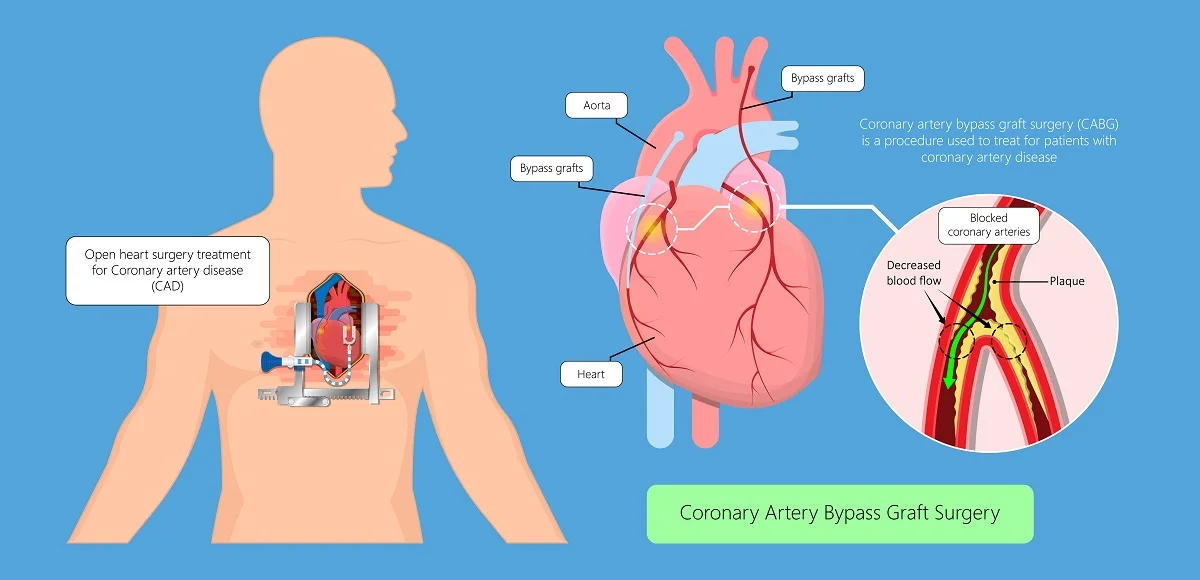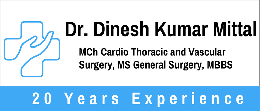Heart Bypass Surgery (CABG): Procedure and Recovery Time

Coronary artery bypass grafting is a joint heart surgery that has improved the lives of coronary artery disease (CAD) patients for a long time. The surgery has improved a lot over the past few decades. It is now also done using minimally invasive techniques. The heart bypass surgery has a success rate of over 98%.
The latest statistical reports show that over 4,00,000 bypass surgeries are performed yearly worldwide. The procedure bypasses the blocked portion of the coronary artery (the artery supplying blood to the heart) by using blood vessel grafts from other parts of the body.
Dr. Dinesh Kumar Mittal is a medical expert on coronary artery bypass grafting (CABG). This life-changing heart surgery has significantly improved the quality of life for patients with coronary artery disease (CAD). With several decades of experience, Dr. Mittal has played a pivotal role in the ongoing advancements of this surgical procedure, making it safer and more effective than ever before.
This blog will help you better understand the heart bypass surgery (CABG) procedure and recovery time.
What is CABG?
Coronary artery bypass grafting, abbreviated as CABG, is a type of cardiac surgery to treat coronary artery disease. Just like any other organ, the heart also needs blood to perform its function of pumping continuously. Coronary arteries are the vessels supplying blood to the cardiac muscles.
A CABG is performed to treat the condition when coronary arteries get blocked or narrowed. It involves bypassing the diseased portion of the artery using grafts. The grafts used for CABG are usually the veins in the leg or arteries from the chest.
A few risks associated with CABG are:
- Bleeding,
- Blood clots
- Infection
- Failure of graft,
- Stroke,
- Heart attack.
Why Do You Need CABG?
Right and left coronary arteries are the two major arteries that supply blood to the heart. With time, these arteries become narrow and hardened because of the deposits of the fat (plaques). The process of fat buildup in the arteries is known as atherosclerosis.
When atherosclerosis of the coronary arteries occurs, the disease is known as coronary artery disease. The chances of developing CAD increase with age, smoking, being overweight, and having a high-fat diet.
Coronary artery disease often leads to angina and heart attack. CABG is the surgery that treats CAD and other conditions associated with it.
Dr. Mittal believes this procedure is vital in preventing heart attacks, improving overall heart function, and enhancing the quality of life for patients facing these challenging cardiac conditions.
How is a CABG Performed?
Before undergoing a CABG procedure, you will meet the cardiac surgeon, who will explain the procedure. He will also conduct a few tests to check whether you are healthy enough to undergo the surgery. Special instructions will be given, which are to be followed before the surgery and also after the surgery.
As per Dr. Dinesh Kumar Mittal, Heart bypass surgery or CABG procedure can be done in the following ways:
Surgery
- CABG is performed under general anesthesia given by an anesthesiologist. The sternum is split into two pieces by incision down the chest’s center.
- The rib cage is then spread and split to access the heart.
- Once the surgeon reaches the heart, they will take the harvested blood vessel and attach one end to the aorta and the other to the blocked artery.
- The lower end of the grafted artery is attached just past the blockage.
- In this way, the blocked part of the coronary artery is bypassed, restoring the normal blood flow.
- Once the surgery is complete, the rib cage is put back into place, and the incision is closed using suture and staples.
Off-Pump CABG
- In off-pump CABG, a heart-lung bypass machine is not used.
- This means the surgeon does not need to stop your heart during the surgery.
- They do all the work while the heart is still beating.
- This surgery is more challenging than on-pump surgery and is only for some patients.
Minimally Invasive CABG
- This type doesn’t involve splitting the sternum and ribcage by making a large incision.
- Instead, the surgeon uses much smaller incisions (usually 2 to 4 inches) and gains access to the heart through the gaps between the ribs.
- The minimally invasive procedure can be done using the off-pump technique.
Robot-Assisted CABG
- Robots are now used for many different surgeries, including CABG.
- In robot-assisted CABG, the cardiac surgeon drives or controls the movements of the surgical robot to perform the procedure.
- It does not involve opening and lifting the sternum and involves smaller incisions.
- Since the incision is small, the recovery is easier and faster with fewer complications.
- The robot-assisted CABG can be done using off-pump and on-pump techniques.
How Much Does Coronary Artery Bypass (CABG) Cost in Delhi?
The cost of Coronary Artery Bypass Grafting (CABG) in Delhi varies due to numerous factors and typically falls within a range of Rs. 1,20,000 to Rs. 4,40,000. In the capital city, the minimum starting price for this procedure begins at Rs. 1,20,000, while the average cost hovers around Rs. 2,40,000. However, the maximum cost for CABG surgery in Delhi can go as high as Rs. 4,40,000.
Note that the cost may vary depending on a number of factors, including hospital facilities, surgeon skill, medical demands, and post-operative care.
What is it Like to Recover From CABG?
- As each body is different, the CABG recovery time might differ for everyone. However, most of the patients make a full recovery from the surgery within 12 weeks.
- The patient can sit on a chair one day after their surgery, walk after three days, and climb stairs after six days. They may feel quickly tired for the first three to six weeks as the body uses the most energy for healing.
- CABG patients resume most of their normal activities within six weeks and can fully recover in 3 months if no complication occurs. Complications are avoided by carefully following the instructions given by the cardiac surgery team. The instructions include taking proper surgical site care, keeping the wound clean and protected from sunlight, etc.
- The patient can walk short distances and lift light weights in the first few days of recovery. After six weeks, the patient can do more strenuous activities like driving, carrying children, lifting weights, vacuuming, etc.
- You can minimize the recovery time from CABG by taking prescribed medicines timely, gradually increasing the activities, taking proper rests, following the physician’s instructions.
Dr. Mittal says, “Heart bypass surgery, or CABG, is a major surgical operation where atheromatous blockages in the coronary arteries are bypassed with the help of grafted veins or arteries. The bypass restores normal blood flow to the ischemic myocardium, which relieves anginal symptoms. The recovery from CABG is a 10-12 week-long process. However, the recovery time may be prolonged if complications occur during or after the surgery.”
A patient, Sarah, who underwent CABG under the care of Dr. Dinesh Kumar Mittal, shares her experience: “Recovery wasn’t easy, but with Dr. Mittal’s guidance, I felt safe and supported. His expertise made all the difference, and today, I’m back to enjoying life with a healthier heart.”
Sarah’s testimonial highlights the crucial role of skilled surgeons like Dr. Mittal in ensuring a successful and reassuring recovery journey.
FAQs
-
What is the success rate of CABG in India?
India’s highly skilled Cardiac Surgeons offer CABG with an overall success rate of 98%.
-
Who is a good candidate for CABG?
An ideal candidate for CABG is someone with a severe form of coronary artery disease (CAD), or more arteries are affected by the blockage.
-
What are the benefits of CABG?
CABG offers benefits like lower risk of stroke, improved blood flow to the heart, relief from symptoms of coronary artery disease, and a return to normal lifestyle.
-
What is the age limit for CABG surgery?
There is no specific age limit for a CABG surgery. Whether you will receive a CABG depends on the patient’s overall health, ability to withstand the procedure and extent of CAD.
-
What foods should be avoided after a CABG?
For a quick recovery from CABG, it’s advised to avoid hydrogenated and trans fat products, sugary food, high sodium diet, alcohol, and refined grains.
